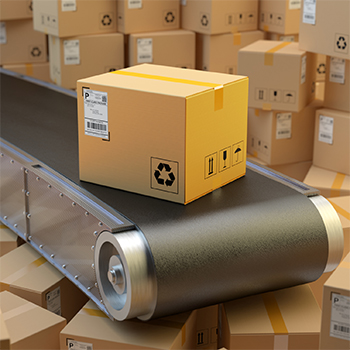The Ever Evolving Parcel Handling Industry

Distribution centers are handling more parcels than ever, and that’s only likely to increase, so here’s how materials handling professionals can meet the challenge.
It’s December. Look out your front door, and you’ll probably see a steady stream of UPS, FedEx and USPS trucks traveling up and down your street, dropping off one parcel package after another.
In some urban neighborhoods, all three may deliver to the same address during the course of a day. And with online sales projected to rise by double digits, no let-up is in sight.
To handle all of those parcel packages, distribution centers and parcel handlers have had to evolve their materials handling and information technology systems in a hurry - and on a variety of levels.
Indeed, no factor in recent memory has fundamentally impacted the industry more than e-commerce, as it has influenced nearly every facet of the supply chain and increased the connectivity between B2B and B2C suppliers and customers.
As a result, the industry has had to focus on efficiency, as volumes and transactions are increasing at an exponential pace.
To keep costs down, order fulfillment operations and parcel handling sortation centers alike must pay attention to every detail.
The phenomenon isn’t limited just to the B2B side of the business. B2C e-commerce is requiring suppliers and industrial distributors to offer the same types of services to their business customers that consumers experience at home.
That has led to the development of new ways to process orders, deliver packages and meet the customer service level requirements, all while overcoming the challenges initiated by the evolution.
“This is such an interesting time for the materials handling industry,” says Chris Assenmacher, CEO of Carter Control Systems. “As technological developments converge with the demand for materials handling, a dynamic atmosphere for innovation has been created.”
With this atmosphere for innovation in mind, two challenges stand out in particular. First, the change to dimensional pricing had led materials handlers to use poly bags more often than corrugated and cardboard cartons; a trend that creates handling issues that were previously not considered, especially for conveyor and sortation systems.
Further, the increase in “each” picking has driven the need for more automation and, consequently, more versatile and compact materials handling systems that must also provide real-time data.
To overcome these challenges, here’s a look at some of the evolving solutions that are currently being implemented.
Dimensional Data Is Now a Factor
Until this year, the cost of shipping a parcel package was based on its weight rather than its cube: As a rule, dimensional rating only applied to air shipments. However, now that carriers realize there has to be a better way to use the space in the back of their trucks, the cubic dimensions are more important than the weight of a package, especially when it comes to calculating the cost of ground shipments.
“Formerly, parcel shippers paid a cost representative of an item’s weight,” says Tim Kraus, manager of product management at Intelligrated. “Today, they must pay for the space an item occupies on a delivery truck to be more in line with the size of an item.”
That, in turn, has resulted in a renewed focus on the size of the package used for parcel shipments. “The newer requirements mean that the actual dimensions and weights of shipments have become vastly important,” says Sean Robinson, sales and marketing manager at QMI Services, a division of CubiScan.
“Operations can now benefit from technology that accurately and efficiently captures the data of packages, even if they are irregularly shaped like poly bags and bubble mailers.”
After scanning items, there are a number of ways to capture data and ensure packaging sizes are accurate and, if necessary, are reduced prior to shipping, thereby lowering costs and increasing bottom lines:
High-speed checkweighers: In addition to recording actual shipping weight, checkweighers compare the expected weight of a package (during inbound scans) to the actual weight of a package.
“The bar code and weight data is merged and transmitted on to either the shipping software or host, providing shippers an opportunity to validate their order picking and reduce the likelihood of inaccuracies,” Robinson says.
If the weight is determined to be higher or lower than anticipated, a checkweigher may send a signal to a reject device that removes the package from the line.
“This signal can either be programmed directly into the checkweigher, especially if the same type of product has been produced in batches typical for packaging operations, or used to dynamically identify each item in real time, per order, as a means of pick verification during distribution,” he explains.
In-motion cubing systems: Cubing is often used in conjunction with checkweighers. Aside from capturing weight, cubing systems also capture the length, width and height of products during the receiving process, and the characteristics of packages before shipping.
According to Robinson, these systems are installed as part of an integrated checkweigher/cubing system or stand alone near the location in which the items are being scanned on the conveyor.
Automated label applications: Once items are scanned, weighed and cubed, shipping label data can be merged and used to print labels that are applied to boxes. In most cases, printer-applicators are used to apply the label to the side or the top of a parcel.
However, many compliance or custom applications now require multiple labels, folded top or side applications, or additional printing of packing lists, each of which are available with automated label applications.
Verification scans: After labels are printed and applied, verification scans ensure the labels are not only legible, but that the correct labels were also applied to the proper packages - a task that is completed by scanning the package ID bar code, along with the shipping label that was just applied.
Solutions for Constantly Evolving Challenges
To keep up with new fulfillment and shipping requirements, the software that manages parcel handling operations must analyze the continuous variations in packaging sizes and materials, provide real-time data about the status of orders and interface with enterprise-level systems.
However, the increase in demand for fast, accurate delivery has led to another necessity: highly automated, transparent equipment that maintains order statuses and delivers data quickly and efficiently.
Bar code readers: To ease the installation process, some of the latest six-sided bar code readers now incorporate imagers and sensors into three pre-assembled parts. These can be calibrated and integrated into traditional materials handling systems in less than one hour.
“The readers also feature controllers with multiple belts and height sensors to ensure product gapping and speed control, resulting in seamless product induction to belt or tray materials handling systems,” says Jonathan Stiles, marketing manager at Datalogic Automation. “And, they are pre-configured and pre-assembled at factories at a fraction of the cost of previous readers.”
Conveyors: At times, poly bags, padded envelopes and other irregularly shaped materials are not detected properly on conveyors, due to their unusual dimensions. To improve their detection capabilities, along with transportation on conveying surfaces, many facilities are replacing conveyor rollers with conventional 3- or 4-inch centers with rollers that feature 2-inch centers.
In addition, the roller conveyors can be converted to belt conveyors or belted motor driven roller zones. “These upgrades provide a more consistent conveying surface, which improves product flow and decreases the risk of jams, improper orientation and side-by-side items,” Intelligrated’s Kraus explains.
Integrating drive systems: Filling a parcel order may require bringing together items picked from a variety of picking zones at one time in a pack station and then sorting them to the right shipping lane. An integrated system of drives and controls provides materials handlers with a customized solution to implement and maintain all of the drive train components necessary to synchronize that process.
“An integrated drive system can be seamlessly integrated in any drive train and in any type of automation environment,” says John Meyer, manager, marketing communications at Siemens. “And, in doing so, materials handlers can reduce their maintenance costs and engineering time by upwards of 15% and 30%, respectively.”
Robotics: Traditionally, robots have been used to handle palletizing and de-palletizing functions. As sensor and vision technologies have improved, new robots are emerging that can be adapted for picking and packing operations as well, says Assenmacher from Carter Control.
“Since we are being asked to create a large number of box sizes during the course of a day than we ever have before, we had to find a solution,” he explains.
As an example, he adds, end users are exploring the use of robots to handle the requirements of box-forming operations.
The next evolution may be the deployment of mobile robotic picking solutions that flexible end-of-arm tooling that can pick a variety of products in different types of order picking scenarios, thereby eliminating the need for human involvement.
“We see a lot of potential in collaborative robots as well, which allows the robot to work side-by-side with humans, without isolating it for safety reasons,” Assenmacher adds. “As the technology matures, we expect these robots to eventually be used in many types of materials handling applications.”
Prepare for the Future of Data Collection
The technology that is used to collect data and track goods from initial development to final delivery is constantly evolving as well. To stay ahead of the curve, some facilities are exploring the following technologies:
3D technology - for robots: “3D technology allows us to fully understand the dimensions of the products we are handling,” Assenmacher says. “In the past, we had to hard code the box dimensions into our systems and identify which boxes were being delivered to the robot. Now, we can dynamically process those dimensions and adjust proactively to handle the box.”
To further increase the capabilities of robots, the 3D technology can also be used for mixed case palletizing and de-palletizing, as well as other picking applications.
“While still in its early stages, as far as materials handling systems are concerned, I believe 3D vision and sensor technology will considerably alter how - and where - robots will be used in materials handling applications,” Assenmacher adds.
Camera-based imaging: Camera-based imaging offers users a variety of process optimization benefits. It is particularly ideal for bar codes that are wrapped around corners, such as poly bags, damaged bar codes or irregularly shaped objects.
“Not only can saved images be used for OCR and video coding applications, but they can also be catalogued for offline, process optimization analysis. Additionally, bar code quality measurements allow users to predict process issues before they become costly,” says Datalogic’s Stiles.
RFID: Unlike bar codes, which only allow facilities to identify products at certain stages of the logistics process, radio-frequency identification (RFID) provides a more comprehensive method for the tracking of goods and products throughout their entire lifecycles.
“It really makes the logistics process more efficient, as materials handlers can see where products are at all times and ensure their safety. I anticipate a widespread adoption over the next several years,” says Assenmacher.
As B2B and B2C e-commerce continues to expand, there is no sign that the evolution of the parcel handling industry will be deterred anytime soon. And, consequently, the demand for materials handling solutions - that capture dimensional data, substantially reduce miscalculations and improve efficiency - will likely only increase.
By actively responding to this demand, materials handling professionals can ensure their products and services are constantly evolving as well, so their customers are better equipped to overcome the challenges of the parcel handling evolution on a long-term basis.
Related: Understanding Accumulation Technology Choices Leads to Better Operation Solutions

Article Topics
Carter Control Systems News & Resources
The Ever Evolving Parcel Handling IndustryLatest in Warehouse|DC
Spotlight Startup: Cart.com is Reimagining Logistics Walmart and Swisslog Expand Partnership with New Texas Facility Taking Stock of Today’s Robotics Market and What the Future Holds U.S. Manufacturing Gains Momentum After Another Strong Month Biden Gives Samsung $6.4 Billion For Texas Semiconductor Plants Walmart Unleashes Autonomous Lift Trucks at Four High-Tech DCs Plastic Pollution is a Problem Many Companies are Still Ignoring More Warehouse|DC
















